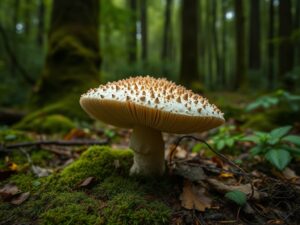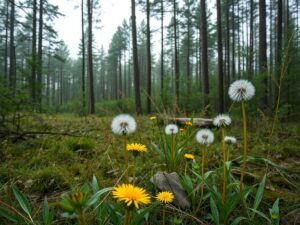Foraging transforms ordinary hikes into opportunities for self-sufficiency. Beginners often start with simple rules to ensure safety and sustainability. Identify a plant with 100 percent certainty before any harvest, using regional guides or expert walks to confirm traits. This precision prevents mishaps from look-alikes.
In forests, understanding hidden connections adds depth. Fungi help plants access water and nutrients, forming networks that sustain the very edibles you seek. Respect these systems by scouting areas away from roads or factories, where contamination risks drop.
Five Core Rules in Your Foraging Guide
Every effective foraging guide begins with structured principles. Follow these to forage responsibly:
- Prioritize Caution: Cross-reference multiple sources for identification. Books by experts like Samuel Thayer offer reliable starting points.
- Know Your Terrain: Research local edibles and toxins. In the Northeast, abundant weeds like dandelions thrive in disturbed spots.
- Harvest Ethically: Adhere to limits, taking no more than 5% of a patch. Harvest responsibly in permitted areas to support regrowth and wildlife.
- Target Weeds: Focus on resilient plants that rebound quickly, minimizing ecological footprint.
- Minimize Impact: Stick to durable surfaces and practice Leave No Trace. Walk lightly and practice Leave No Trace to preserve habitats.
These rules, drawn from trail-tested advice, empower you to explore confidently. They address common concerns like overharvesting in sensitive zones such as wetlands.
Identifying Easy Edibles: A Foraging Guide Essential
Abundant plants make ideal entry points. Dandelions grow all over and every part is edible, from roots for roasting to flowers for fritters. Spot them in lawns or trailsides, their jagged leaves unmistakable.
Watercress adds spice to salads. Watercress in wetland areas with fleshy stems features small white flowers and thrives mid-spring to fall. Harvest stems and leaves from clean streams, avoiding polluted waters.
Wild strawberries hide in sunny forests up to 10,000 feet. Look for egg-shaped leaves with serrated edges and five-petaled flowers. Berries peak in summer, perfect for fresh eating or teas.
Mint rounds out basics, with mint with squared stems along riverbanks. Its opposite leaves release aroma when crushed, ideal for infusions.
| Plant | Habitat | Edible Parts | Best Season |
|---|---|---|---|
| Dandelion | Disturbed soils, lawns | Roots, leaves, flowers | All year |
| Watercress | Wetlands, streams | Stems, leaves, flowers | Spring-Fall |
| Wild Strawberry | Sunny forests, meadows | Fruit, leaves, flowers | Summer |
| Mint | Riverbanks, moist soils | Leaves | Summer-Fall |
This table simplifies selection, helping you plan based on location and season. Such tools turn a foraging guide into a practical companion.
The Role of Forests in Foraging
Forests offer more than plants; they host intricate below-ground alliances. Mycorrhiza is a symbiotic relationship between fungus and plant roots, where fungi trade nutrients for plant sugars. Ectomycorrhizae sheath roots of conifers like pine, extending reach into soil.
These networks, sometimes called the wood-wide web, connect trees for resource sharing. However, they remain fragile, disrupted by soil activity. For foragers, this means choosing spots with diverse trees to support healthy populations.
In the Northeast, ectomycorrhizae partner with oaks and birches, while arbuscular types aid maples. Nearly all plant species form mycorrhizal relationships, underscoring why light foraging preserves vitality.
- Scout diverse woodlands for varied edibles.
- Avoid clearings from recent disturbances, as recovery relies on fungal dispersal by small mammals.
- Retain legacy trees to maintain networks during any land use.
Understanding these dynamics elevates your foraging guide from mere collection to ecosystem stewardship.
Real-World Foraging Stories
Personal experiences highlight foraging’s rewards. One account describes a five-day ultralight trip relying on wild greens like nettle and lamb’s quarter. Cooking them over a fire brought a sense of abundance, despite the challenge.
Such tales remind us of nature’s pantry. In forests, fungi obtain carbon from plants in exchange for nutrients, mirroring the give-and-take of sustainable harvest.
Simple Recipes from Your Foraging Guide
Turn finds into meals with ease. For a pine infusion: Clip small branches from pine or spruce, avoiding toxic yew. Cover with tequila or vinegar, add honey, and steep for a week, shaking daily. Mix with juices for a foraged margarita. Clip pine branches and steep in spirit for infusion.
Nettle soup starts with young leaves blanched to remove sting, simmered with garlic. Dandelion fritters involve battering flowers and frying until crisp.
- Ingredients for Wild Green Salad: Watercress, dandelion leaves, wild strawberry flowers, mint; dress with vinegar.
- Preparation Tips: Rinse thoroughly; cook nettles to neutralize irritants.
- Variations: Add roasted roots for heartiness.
These recipes, rooted in abundance, make foraging rewarding. They fit seamlessly into a trail lifestyle, proving wild foods nourish body and spirit.
Advanced Tips for Ethical Foraging
Expand your foraging guide with knowledge of poisons. Study poisonous plants that mimic edibles, like those causing rashes or worse. Traits such as milky sap often signal danger.
In forests, support fungi by minimizing soil disturbance. Promote diversity through varied tree ages, leaving deadwood for moisture.
For urban foragers, neighborhood patches of weeds offer safe starts. Always check local regulations to ensure compliance.
Integrating Foraging into Daily Life
Foraging fosters connection to place. Beginners gain skills through practice, from plant walks to home infusions. This foraging guide equips you for bountiful, responsible adventures, blending safety with discovery.
FAQs
- What are the biggest risks in foraging?
Misidentification tops the list; always verify with 100% certainty using multiple sources to avoid toxic plants. - Can I forage in any forest?
Stick to permitted areas, avoiding contaminated sites near roads. Check local guidelines for restrictions. - How do fungi affect what I can forage?
Mycorrhizal networks sustain plant health, so light harvesting preserves these vital underground connections. - What if I’m new to recipes?
Start simple: Infuse pine in spirits or make salads from weeds like dandelion for easy, nutritious meals.

